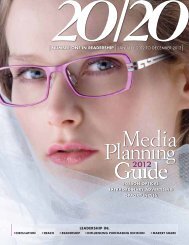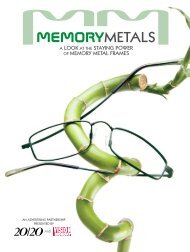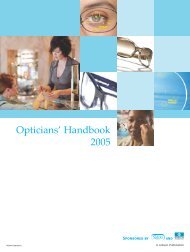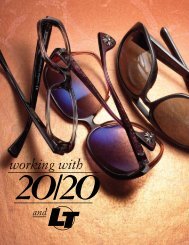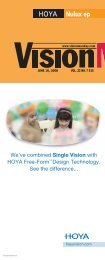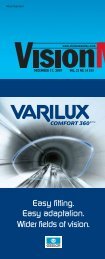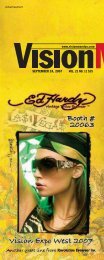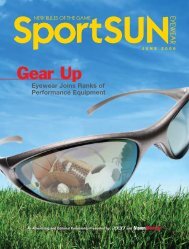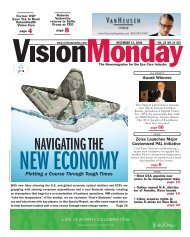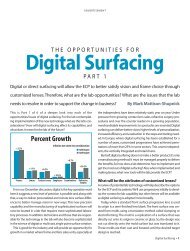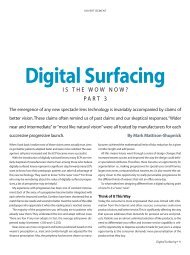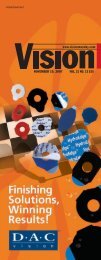The Opportunities For Digital Surfacing - Part 2
The Opportunities For Digital Surfacing - Part 2
The Opportunities For Digital Surfacing - Part 2
Create successful ePaper yourself
Turn your PDF publications into a flip-book with our unique Google optimized e-Paper software.
ADVERTISEMENT<br />
and jerk behavior in order to calculate the<br />
optimal feed rate for each individual lens.<br />
Once the designs are available to labs, the<br />
assumption must be made that the designer<br />
has confirmed that the design corrects eyesight<br />
in the way intended.<br />
Manufacturers have begun to license their<br />
design files through programs where they<br />
will assist in the correct transfer of the design through the lab for delivery to<br />
the ECP.<br />
<strong>For</strong> example, Essilor has begun <strong>Digital</strong> <strong>Surfacing</strong> Extended Offering<br />
(DEO). Beginning third quarter, the first independent laboratory will offer<br />
Varilux 360° as part of a turnkey package. With equipment specified by<br />
Essilor and with software to download instructions from an Essilor server,<br />
the designs will be transferred to the lab for manufacture.To ensure accuracy<br />
of design and patient satisfaction,sample control lenses are sent daily<br />
to Essilor for analysis and verification. Adjustments can be made in real<br />
time.To complete the delivery of premium vision in design, Crizal Alizé is<br />
also available to these labs.<br />
Process Integration – Like the doctor’s office that purchases a variety of<br />
instruments and then needs to add the test data to the patient’s record<br />
as part of an electronic medical record,instrument software is required to<br />
“talk”to practice management systems to increase office efficiency. Why<br />
enter patient name and data multiple times in an electronic record when<br />
an integration of the systems can do it <strong>The</strong> same is now possible for the<br />
lab so that electronic data systems transfer machine-operating instructions<br />
for the Rx needed by any bar coded tray.<br />
Who’s on board Visionstar,CC Systems and <strong>Digital</strong> Vision lab management<br />
systems support “connectivity”with some of the generator companies.<br />
Be sure to review system capability and implementation of the VCA<br />
communication protocol.<br />
Implementation – Each lab should expect the same learning curve when<br />
installing new equipment and new software digital surfacing with one<br />
major difference. When installing direct or digital surfacing, one should<br />
expect a higher level of support from the lens design source, lab management<br />
software company and equipment supplier since the integration<br />
of these tools is essential for success.In fact,<br />
it is the responsibility of the lens design source<br />
to initially ensure that the design is correct since<br />
that’s the license being secured.<br />
Milling Characteristics – In the past, the lab<br />
had to determine the materials that were most<br />
often ordered when choosing equipment.<br />
Today,the digital surfacing generator is capable<br />
of cutting all materials and polishing requires adjustment depending on<br />
material. <strong>For</strong> example, the high utilization of polycarbonate in the U.S.<br />
affects machine efficiency.<strong>The</strong> Schneider HSC generator series incorporates<br />
three major changes for polycarbonate. First, the milling tool cuts<br />
short chips which are easier to clear from the chamber. Next, the cutting<br />
tool is positioned upside down to take advantage of gravity.And last,the<br />
work space is inclined to enhance swarf<br />
removal.<br />
Standard sphere and toric curves are cut by<br />
polycrystalline diamond (PCD),complex curves<br />
(progressives) require natural diamond for the<br />
smoothest surface.<br />
Surface Protection and Blocking – Blocking<br />
and surface protection is the same as it is for standard surfacing i.e., there<br />
are material stresses created by pressure and temperature, specific to lens<br />
material. <strong>For</strong> example, a lens whose front surface is spherical to start, after<br />
blocking and generating may be correct in design after cutting but once<br />
removed from the block, incorrect in design.This has been the same for<br />
standard progressives when blocking alloy has been too hot, lenses<br />
weren’t allowed to cool sufficiently before generating or too small a diameter<br />
block used.<strong>The</strong> surface “warps” and the corridor may have become<br />
unusable yet the distance and near values were correct. In addition, the<br />
blocking tolerances for digital surfacing are tighter.<br />
Centering of the Optic - <strong>For</strong> lenses with engravings on the front, exact centering<br />
is required without blocking errors that might make the optics drift in<br />
position. Some believe that engraving after the lens is manufactured is better,it<br />
marks what you have done,not what you would like to have done.<strong>The</strong><br />
other opportunity is to use digitally surfaced lenses that have front and back<br />
optics where a majority of the progressive surface is already on the front and<br />
the engravings have been applied to the mold prior to the casting process.<br />
Cutter Position and Data Feed – <strong>The</strong> maximum speed achieved for cutting<br />
with the precision required depends on the complexity of the surface. <strong>For</strong><br />
complex surfaces,the maximum stroke,acccelleration and jerk of the motor<br />
sets minimum processing time limits.<br />
Polishing – How has the more difficult<br />
polishing process been developed and<br />
what are the attributes of well-polished<br />
lenses <strong>The</strong> surface has been prepared<br />
to be as smooth and near transparent<br />
as possible,however,the fineness of cut<br />
is not yet possible to just allow a coating<br />
to complete the lens. As a result, a<br />
slight buffing or polish is required.<strong>The</strong><br />
Polishingconformable<br />
tools, variable<br />
paths.<br />
Twin tools,<br />
PCD and<br />
natural<br />
diamond.<br />
use of hard laps are not possible because those will destroy the surface shape,<br />
therefore soft and conformable tools have been developed to buff the surface.<strong>The</strong>y<br />
adjust to the shape of the surface.In addition,different tool radii are<br />
used to best match the surface curves generated.<br />
Special oscillation and polishing paths help ensure that the surface created<br />
is well polished.As a result,the software developed to guide lens path over the<br />
tool and the tools chosen are different for each lens surface.<strong>The</strong> equipment<br />
software and lab management software work together to understand which<br />
lens is being worked on so the correct polishing is completed.<br />
What Are the Economics<br />
<strong>For</strong> small labs, purchase is difficult.<strong>The</strong>re is the high capital outlay, from<br />
$500 thousand to $1 million dollars. Since the overall volume of digitally<br />
2• <strong>Digital</strong> <strong>Surfacing</strong>



